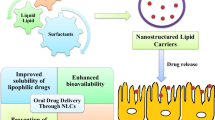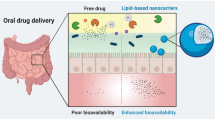Abstract
Poorly soluble drugs must be appropriately formulated for clinical use to increase the solubility, dissolution rate, and permeation across the intestinal epithelium. Polymeric and lipid nanocarriers have been successfully investigated for this aim, and their physicochemical properties, and in particular, the surface chemistry, significantly affect the pharmacokinetics of the drugs after oral administration. In the present study, PLGA nanoparticles (SS13NP) and solid lipid nanoparticles (SS13SLN) loaded with SS13, a BCS IV model drug, were prepared. SS13 bioavailability following the oral administration of SS13 (free drug), SS13NP, or SS13SLN was compared. SS13NP had a suitable size for oral administration (less than 300 nm), a spherical shape and negative zeta potential, similarly to SS13SLN. On the contrary, SS13NP showed higher physical stability but lower encapsulation efficiency (54.31 ± 6.66%) than SS13SLN (100.00 ± 3.11%). When orally administered (0.6 mg of drug), SS13NP showed higher drug AUC values with respect to SS13SLN (227 ± 14 versus 147 ± 8 µg/mL min), with higher Cmax (2.47 ± 0.14 µg/mL versus 1.30 ± 0.15 µg/mL) reached in a shorter time (20 min versus 60 min). Both formulations induced, therefore, the oral bioavailability of SS13 (12.67 ± 1.43% and 4.38 ± 0.39% for SS13NP and SS12SLN, respectively) differently from the free drug. These in vivo results confirm that the chemical composition of nanoparticles significantly affects the in vivo fate of a BCS IV drug. Moreover, PLGA nanoparticles appear more efficient and rapid than SLN in allowing drug absorption and transport to systemic circulation.
Graphical abstract








Similar content being viewed by others
Data availability
The datasets generated during and/or analyzed during the current study are available from the corresponding author upon reasonable request.
References
Benet LZ, Broccatelli F, Oprea TI. BDDCS applied to over 900 drugs. AAPS J. 2011;13:519–47.
Kalepu S, Nekkanti V. Improved delivery of poorly soluble compounds using nanoparticle technology: a review. Drug Deliv Transl Res. 2016;6:319–32.
Committee for Medicinal Products for Human Use, EMA. ICH M9 guideline on biopharmaceutics classification system-based biowaivers. 2020. Available from: https://www.ema.europa.eu/en/documents/scientific-guideline/ich-m9-biopharmaceutics-classification-system-based-biowaivers-step-5_en.pdf. Accessed 3 Oct 2022.
Ghadi R, Dand N. BCS class IV drugs: highly notorious candidates for formulation development. J Controlled Release. 2017;248:71–95.
Ghosh S, Ghosh S, Sil PC. Role of nanostructures in improvising oral medicine. Toxicol Rep. 2019;6:358–68.
Wang Y, Pi C, Feng X, Hou Y, Zhao L, Wei Y. The influence of nanoparticle properties on oral bioavailability of drugs. Int J Nanomedicine. 2020;15:6295–310.
Nieto González N, Obinu A, Rassu G, Giunchedi P, Gavini E. Polymeric and lipid nanoparticles: which applications in Pediatrics? Pharmaceutics. 2021;13:670.
Plaza-Oliver M, Santander-Ortega MJ, Lozano MV. Current approaches in lipid-based nanocarriers for oral drug delivery. Drug Deliv Transl Res. 2021;11:471–97.
Åslund AKO, Vandebriel RJ, Caputo F, de Jong WH, Delmaar C, Hyldbakk A, Rustique E, Schmid R, Snipstad S, Texier I, Vernstad K, Borgos SEF. A comparative biodistribution study of polymeric and lipid-based nanoparticles. Drug Deliv Transl Res. 2022;12:2114–31.
Guo S, Liang Y, Liu L, Yin M, Wang A, Sun K, Li Y, Shi Y. Research on the fate of polymeric nanoparticles in the process of the intestinal absorption based on model nanoparticles with various characteristics: size, surface charge and pro-hydrophobics. J Nanobiotechnology. 2021;19:32.
Banerjee A, Qi J, Gogoi R, Wong J, Mitragotri S. Role of nanoparticle size, shape and surface chemistry in oral drug delivery. J Control Release. 2016;238:176–85.
Obinu A, Porcu EP, Piras S, Ibba R, Carta A, Molicotti P, Migheli R, Dalpiaz A, Ferraro L, Rassu G, Gavini E, Giunchedi P. Solid Lipid Nanoparticles as formulative strategy to increase oral permeation of a molecule active in multidrug-resistant tuberculosis management. Pharmaceutics. 2020;12:1132.
Obinu A, Burrai GP, Cavalli R, Galleri G, Migheli R, Antuofermo E, Rassu G, Gavini E, Giunchedi P. Transmucosal solid lipid nanoparticles to improve genistein absorption via intestinal lymphatic transport. Pharmaceutics. 2021;13:267.
Shailender J, Ravi PR, Saha P, Dalvi A, Myneni S. Tenofovir disoproxil fumarate loaded PLGA nanoparticles for enhanced oral absorption: effect of experimental variables and in vitro, ex vivo and in vivo evaluation. Colloids Surf B Biointerfaces. 2017;158:610–9.
Sharma S, Parmar A, Kori S, Sandhir R. PLGA-based nanoparticles: a new paradigm in biomedical applications. TrAC Trends Anal Chem. 2016;80:30–40.
Nallamuthu I, Parthasarathi A, Khanum F. Thymoquinone-loaded PLGA nanoparticles: antioxidant and anti-microbial properties. Int Curr Pharm J. 2013;2:202–7.
Xie X, Tao Q, Zou Y, Zhang F, Guo M, Wang Y, et al. PLGA nanoparticles improve the oral bioavailability of curcumin in rats: characterizations and mechanisms. J Agric Food Chem. 2011;59:9280–9.
Talegaonkar S, Bhattacharyya A. Potential of Lipid Nanoparticles (SLNs and NLCs) in enhancing oral bioavailability of drugs with poor intestinal permeability. AAPS PharmSciTech. 2019;20:121.
Ji H, Tang J, Li M, Ren J, Zheng N, Wu L. Curcumin-loaded solid lipid nanoparticles with Brij78 and TPGS improved in vivo oral bioavailability and in situ intestinal absorption of curcumin. Drug Deliv. 2016;23:459–70.
Araújo F, Shrestha N, Shahbazi M-A, Fonte P, Mäkilä EM, Salonen JJ, et al. The impact of nanoparticles on the mucosal translocation and transport of GLP-1 across the intestinal epithelium. Biomaterials. 2014;35:9199–207.
Panigrahi KC, Patra ChN, Jena GK, Ghose D, Jena J, Panda SK, et al. Gelucire: a versatile polymer for modified release drug delivery system. Future J Pharm Sci. 2018;4:102–8.
Dalpiaz A, Paganetto G, Pavan B, Fogagnolo M, Medici A, Beggiato S, Perrone D. Zidovudine and ursodeoxycholic acid conjugation: design of a new prodrug potentially able to bypass the active efflux transport systems of the central nervous system. Mol Pharm. 2012;9:957–68.
Jin C, Bai L, Wu H, Song W, Guo G, Dou K. Cytotoxicity of paclitaxel incorporated in PLGA nanoparticles on hypoxic human tumor cells. Pharm Res. 2009;26:1776–84.
Nieto González N, Cerri G, Molpeceres J, Cossu M, Rassu G, Giunchedi P, Gavini E. Surfactant-free chitosan/cellulose acetate phthalate nanoparticles: an attempt to solve the needs of captopril administration in Paediatrics. Pharmaceuticals. 2022;15:662.
Simovic S, Heard P, Hui H, Song Y, Peddie F, Davey AK, Lewis A, Rades T, Prestidge CA. Dry hybrid lipid-silica microcapsules engineered from submicron lipid droplets and nanoparticles as a novel delivery system for poorly soluble drugs. Mol Pharm. 2009;6:861–72.
Estrada-Fernández AG, Román-Guerrero A, Jiménez-Alvarado R, Lobato-Calleros C, Alvarez-Ramirez J, Vernon-Carter EJ. Stabilization of oil-in-water-in-oil (O1/W/O2) Pickering double emulsions by soluble and insoluble whey protein concentrate-gum Arabic complexes used as inner and outer interfaces. J Food Eng. 2018;221:35–44.
Mansur HS, Sadahira CM, Souza AN, Mansur AAP. FTIR spectroscopy characterization of poly (vinyl alcohol) hydrogel with different hydrolysis degree and chemically crosslinked with glutaraldehyde. Mater Sci Eng C. 2008;28:539–48.
Xia D, Quan P, Piao H, Piao H, Sun S, Yin Y, Cui F. Preparation of stable nitrendipine nanosuspensions using the precipitation–ultrasonication method for enhancement of dissolution and oral bioavailability. Eur J Pharm Sci. 2010;40:325–34.
Dalpiaz A, Gavini E, Colombo G, Russo P, Bortolotti F, Ferraro L, Tanganelli S, Scatturin A, Menegatti E, Giunchedi P. Brain uptake of an anti-ischemic agent by nasal administration of microparticles. J Pharm Sci. 2008;97:4889–903.
Rassu G, Soddu E, Cossu M, Brundu A, Cerri G, Marchetti N, Ferraro L, Regan RF, Giunchedi P, Gavini E, Dalpiaz A. Solid microparticles based on chitosan or methyl-β-cyclodextrin: a first formulative approach to increase the nose-to-brain transport of deferoxamine mesylate. J Control Release. 2015;201:68–77.
Gavini E, Rassu G, Ferraro L, Generosi A, Rau JV, Brunetti A, Giunchedi P, Dalpiaz A. Influence of chitosan glutamate on the in vivo intranasal absorption of rokitamycin from microspheres. J Pharm Sci. 2011;100:1488–502.
Dalpiaz A, Fogagnolo M, Ferraro L, Capuzzo A, Pavan B, Rassu G, Salis A, Giunchedi P, Gavini E. Nasal chitosan microparticles target a zidovudine prodrug to brain HIV sanctuaries. Antiviral Res. 2015;123:146–57.
de Oliveira Junior ER, Truzzi E, Ferraro L, Fogagnolo M, Pavan B, Beggiato S, Rustichelli C, Maretti E, Lima EM, Leo E, Dalpiaz A. Nasal administration of nanoencapsulated geraniol/ursodeoxycholic acid conjugate: towards a new approach for the management of Parkinson’s disease. J Control Release. 2020;321:540–52.
Djekic L, Janković J, Rašković A, Primorac M. Semisolid self-microemulsifying drug delivery systems (SMEDDSs): Effects on pharmacokinetics of acyclovir in rats. Eur J Pharm Sci. 2018;121:287–92.
Jin Y, Yu L, Xu F, Zhou J, Xiong B, Tang Y, Li X, Liu L, Jin W. Pharmacokinetics of active ingredients of salvia miltiorrhiza and carthamus tinctorius in compatibility in normal and cerebral ischemia rats: a comparative study. Eur J Drug Metab Pharmacokinet. 2020;45:273–84.
Acknowledgements
The authors acknowledge the GAUSS (Grandi Attrezzature Università di Sassari) core facility of the University of Sassari and Marzia Mureddu for TEM analysis.
Funding
This work was supported by the Sardinia Regional Government (FSC 2014–2020 programmes of Regione Autonoma della Sardegna; Grant numbers RASSR01499) and by the Foundation of Sardinia (Bando Fondazione di Sardegna – 2018–2020 e 2021 – Progetti di ricerca di base dipartimentali”; grant numbers J89J21015120005).
Author information
Authors and Affiliations
Contributions
Elisabetta Gavini, Giovanna Rassu, and Paolo Giunchedi contributed to the study’s conception and design. Material preparation, data collection, and analysis were performed by Antonella Obinu, Alessandro Dalpiaz, Luca Ferraro, and Carla Serri. Sandra Piras and Antonio Carta designed and synthesized the drug. Antonio Carta and Paolo Giunchedi acquired the funding. The first draft of the manuscript was written by Giovanna Rassu, and all authors commented on previous versions of the manuscript. All authors read and approved the final manuscript.
Corresponding author
Ethics declarations
Ethics approval
All institutional and national guidelines for the care and use of laboratory animals were followed. This study was performed in accordance with the European Communities Council Directive of September 2010 (2010/ 63/EU). Approval was granted by the Ethics Committee of the University of Ferrara and by the Italian Ministry of Health (No 793/2018-PR).
Consent for publication
All authors have read and agreed to the published version of the manuscript.
Competing interests
The authors declare no competing interests.
Additional information
Publisher's Note
Springer Nature remains neutral with regard to jurisdictional claims in published maps and institutional affiliations.
Rights and permissions
Springer Nature or its licensor (e.g. a society or other partner) holds exclusive rights to this article under a publishing agreement with the author(s) or other rightsholder(s); author self-archiving of the accepted manuscript version of this article is solely governed by the terms of such publishing agreement and applicable law.
About this article
Cite this article
Rassu, G., Obinu, A., Serri, C. et al. Improving in vivo oral bioavailability of a poorly soluble drug: a case study on polymeric versus lipid nanoparticles. Drug Deliv. and Transl. Res. 13, 1128–1139 (2023). https://doi.org/10.1007/s13346-022-01278-4
Accepted:
Published:
Issue Date:
DOI: https://doi.org/10.1007/s13346-022-01278-4




